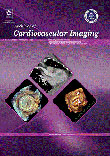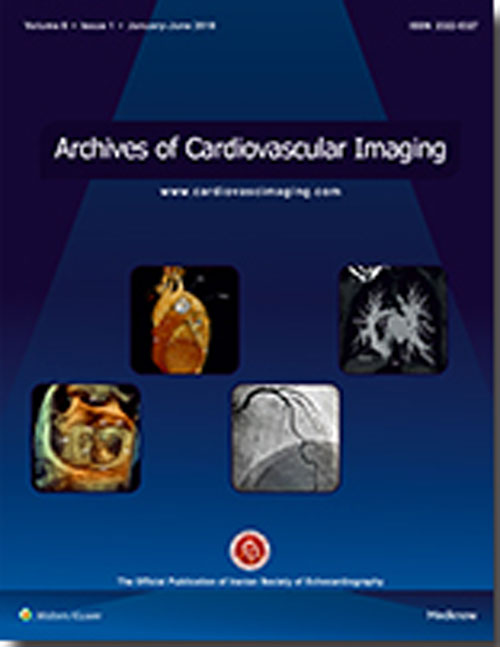فهرست مطالب

Archives Of Cardiovascular Imaging
Volume:3 Issue: 1, Feb 2015
- تاریخ انتشار: 1394/02/12
- تعداد عناوین: 7
-
-
Page 1BackgroundVelocity vector imaging (VVI) is a new echocardiography method to assess myocardial deformation in two dimensions..ObjectivesIn this study, we used VVI to evaluate left ventricular (LV) main torsional parameters in non-ischemic dilated cardiomyopathy (DCM) patients in compared with normal subjects..Patients andMethodsTwenty-six DCM patients and Twenty-four normal subjects were assessed. Echocardiographic images of the short axis apical and basal views of LV were processed by VVI software to measure peak rotation degrees and also peak rotation rates in systole. LV twist was well-defined as the net difference between apical and basal rotation values and also LV torsion was considered as LV twist divided by left ventricular diastolic longitudinal length. In addition, peak untwisting value and untwisting rate were measured in diastole too..ResultsLV twist value (5.54 ± 1.94° in DCM VS. 11.5 ± 2.45° in control group) and also LV torsion (0.71 ± 0.28°/cm in DCM VS. 1.53 ± 0.42°/cm in control group) were significantly decreased in DCM patients compared with normal group (P < 0.001 for both); also, the twisting rate was notably lower in DCM vs. control (38.68 ± 14.43°/s in DCM vs. 75.88 ± 17.25°/s in control; P < 0.001) and also untwisting rate (36.28 ± 13.48°/s in DCM vs. -73.79 ± 24.45°/s in control; P < 0.001), However normalization of these times for systolic duration or LV length creates different values..ConclusionsLV twist, torsion and untwist and also rate of them are significantly impaired in DCM and this impairment is well-related to LV global systolic and diastolic dysfunction. VVI is a new noninvasive technique that can be used to evaluate LV torsional parameters..Keywords: Cardiomyopathy, Dilated, Echocardiography, Torsional Parameters, Non, ischemic Dilated Cardiomyopathy
-
Page 2BackgroundVibratory innocent murmur is the most common precordial innocent murmur in children. The mechanism of vibratory innocent murmur is still unclear..ObjectivesThe aim of this study is to learn the mechanism of the vibratory innocent murmur..Patients andMethodsThe prospective cross-sectional study was conducted using 32 children who had the vibratory innocent murmur (cases) in Chiang Mai University Hospital and 27 normal healthy children (controls). Two-dimension, Doppler, and tissue Doppler echocardiography were performed on each subject to examine the difference between cases and controls..ResultsThe left ventricular false tendon was present in 84% of cases and 22% of controls (P < 0.001). Left ventricular outflow tract velocity was significantly higher in cases than in controls (P < 0.001). Early diastolic myocardial velocity at the base of the interventricular septum was lower in cases with false tendon than those without false tendon (P = 0.048). No significant difference was found regarding ascending aorta diameter, cardiac output and ejection fraction between the two groups. Left ventricular diastolic function was normal in all cases and controls..ConclusionsThe vibratory innocent murmur is associated with the presence of left ventricular false tendon and higher left ventricular outflow tract velocity. The presence of the left ventricular false tendon was somewhat associated with decreased early diastolic myocardial velocity. Normal left ventricular systolic and diastolic function can be used as a reassurance in cases with the vibratory innocent murmur..Keywords: Echocardiography, Doppler, Heart Murmurs
-
Page 3BackgroundTissue Doppler is a promising method that allows the measurement of time of systolic and diastolic tissue velocities. Ventricular dyssynchrony was assessed in patients with heart failure. In sub-Saharan Africa, very few studies have focused on ventricular dyssynchrony in healthy subjects..ObjectivesThe purpose of this study was to measure time-to-peak of systolic and diastolic velocities of different segments of left ventricle and apply ventricular dyssynchrony markers to healthy black African subjects..Patients andMethodsFifty healthy black African were enrolled consecutively over a period of 3 months. Time-to-peak systolic velocities (TS) and Time-to-peak early diastolic velocities (TE) were measured at the four basal segments of left ventricle. Five dyssynchrony markers were assessed: difference between maximal time-to-peak systolic velocity and minimal time-to-peak systolic velocity, time between septal time-to-peak systolic velocity and lateral time-to peak systolic velocity, standard deviation of time-to-peak systolic velocity of the four basal segments, difference between maximal time-to-peak early diastolic velocity and minimal time-to-peak early diastolic velocity, and standard deviation of time-to-peak early diastolic velocity of the four basal segments..ResultsThe frequency of some dyssynchrony markers was similar to that of other studies. The difference between maximal time-to-peak systolic velocity and minimal time-to-peak systolic velocity was correlated with age and was higher among women. The prevalence of diastolic dyssynchrony was higher in black African subjects..ConclusionsLarge-scale studies on the healthy black African population could assess the relationship between diastolic dyssynchrony and changes in myocardial performance related to racial differences..Keywords: Ventricular Dyssynchrony, Tissue Doppler Imaging, Healthy Subjects
-
Page 4IntroductionCoronary angiography can be complicated by some major complications such as stroke..Case PresentationWe describe a patient who presented with hemiparesia. He had undergone coronary angiography on his right and left coronary arteries as well as his left ventricle (LV) via the radial artery access 10 days earlier using a 6-French Tiger catheter. Transthoracic echocardiography showed a large (36 × 25 mm) inhomogeneous mobile mass attached to the apicoseptal LV segment. His serum protein S was low (60% [normal = 77 - 140%]), while his protein C was normal and lupus anticoagulant was negative. During hospitalization, he developed severe abdominal pain, for which mesenteric ischemia was diagnosed. First, he underwent surgery for the resection of the infarcted intestinal segments. Then cardiac surgery was done to remove the mass. The mass was diagnosed as a thrombus. After the surgery, the general condition of the patient deteriorated and blood culture showed acinetobacter septicemia. Finally, he died due to sepsis. A review of his coronary angiography revealed that after the contrast media had left the LV, there was still dye at the contact point between the tip of the catheter and the LV, which was compatible with the location of thrombus formation..ConclusionsTrauma induced by the tip of the catheter at the contact location with the LV wall in a patient with mild hypercoagulable state accounted for intracardiac thrombosis formation and its embolization to the brain and intestines..Keywords: Angiography, Thrombosis, Stroke, Ischemia
-
Page 5IntroductionThe term hydropneumopericardium describes the simultaneous accumulation of fluid and gas in the pericardial sac. This condition is mostly caused by primary infiltrative lesions from the adjacent organs, pericardial infections, or trauma and is a very rare situation, usually with favorable outcomes..Case PresentationWe describe a female patient with Lutembacher’s syndrome complicated by cardiac tamponade. After surgical treatment, she developed iatrogenic hydropneumopericardium, which was treated conservatively..ConclusionsIatrogenic hydropneumopericardium can be managed conservatively with supportive measures, and most of these cases resolve spontaneously if they are not large and destabilizing..Keywords: Pericardial Effusion, Pneumopericardium, Lutembacher's Syndrome
-
Page 6IntroductionThe diagnosis of myocarditis based on a spectrum of findings, including symptoms, clinical examination, electrocardiography, biomarkers, and echocardiography, can be non-specific. Cardiac magnetic resonance imaging (MRI), has become the primary noninvasive technique in patients with suspected myocarditis in some countries..Case PresentationWe present a case with a typical picture of myocarditis but normal echocardiographic findings, the diagnosis of which was confirmed by cardiac MRI..DiscussionIn particular, cardiac MRI data are useful in borderline cases or in the presence of discrepancy between clinical picture and echocardiographic results.Keywords: Echocardiography, Magnetic Resonance Imaging, Myocarditis


